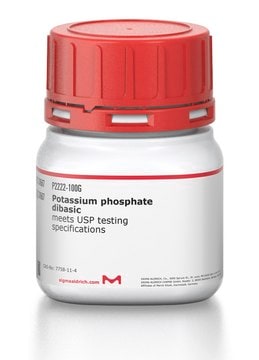P5504
Potassium phosphate dibasic trihydrate
ReagentPlus®, ≥99.0%
Sinônimo(s):
Dipotassium hydrogen phosphate trihydrate, Dipotassium phosphate, di-Potassium hydrogen phosphate trihydrate
About This Item
Produtos recomendados
Nível de qualidade
linha de produto
ReagentPlus®
Ensaio
≥99.0%
forma
powder or crystals
pH
9.2-9.4 (25 °C, 50 g/L)
solubilidade
water: 100 mg/mL, clear, colorless
temperatura de armazenamento
room temp
cadeia de caracteres SMILES
O.O.O.[K+].[K+].OP([O-])([O-])=O
InChI
1S/2K.H3O4P.3H2O/c;;1-5(2,3)4;;;/h;;(H3,1,2,3,4);3*1H2/q2*+1;;;;/p-2
chave InChI
XQGPKZUNMMFTAL-UHFFFAOYSA-L
Procurando produtos similares? Visita Guia de comparação de produtos
Descrição geral
Aplicação
Informações legais
Código de classe de armazenamento
13 - Non Combustible Solids
Classe de risco de água (WGK)
WGK 1
Ponto de fulgor (°F)
Not applicable
Ponto de fulgor (°C)
Not applicable
Equipamento de proteção individual
Eyeshields, Gloves, type N95 (US)
Choose from one of the most recent versions:
Certificados de análise (COA)
Don't see the Right Version?
If you require a particular version, you can look up a specific certificate by the Lot or Batch number.
Já possui este produto?
Encontre a documentação dos produtos que você adquiriu recentemente na biblioteca de documentos.
Os clientes também visualizaram
Protocolos
Enzymatic Assay of Superoxide Dismutase
Nossa equipe de cientistas tem experiência em todas as áreas de pesquisa, incluindo Life Sciences, ciência de materiais, síntese química, cromatografia, química analítica e muitas outras.
Entre em contato com a assistência técnica





